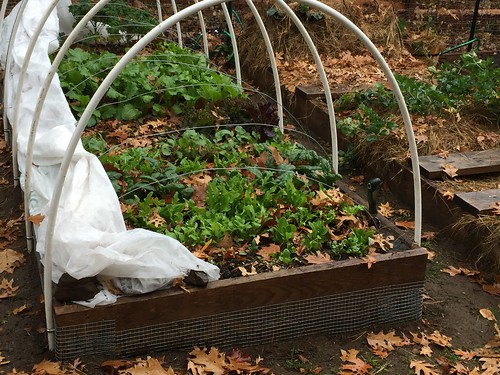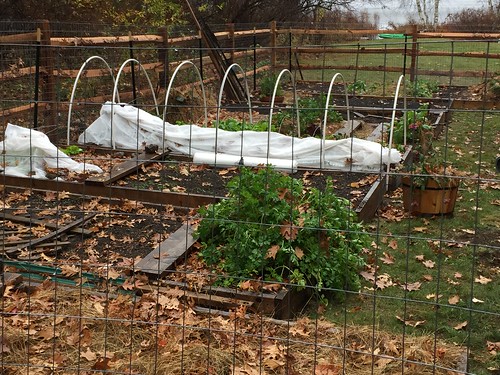

Right now, the skeleton of a tunnel is standing. Bare white PVC arches over thin metal hoops. When night time temperatures dip to freezing (32F), I pull cloth over the metal hoops and then remove it in the morning.
I'm hoping to get some use out of the tunnel this year. Last year, voles or chipmunks ate everything inside once I closed the plastic up.
This year's attempt to keep critters out:
- 6 inches of hardware cloth dug in around the edges of bed
- castor oil/soap mix soaked into soil at edges of bed
- I'll secure the plastic to edges of bed when I close it up
- Watch carefully for holes the past weeks so I don't close it up with a critter inside
It would be nice to have salad greens all winter. We'll see.
I'm still not sure about the plastic tunnel concept. I've read that it works, but still haven't done it successfully myself. Mine is so far from any heat source (except the sun and soil). I suspect it's success depends on the winter weather - snow cover, sunny days, temperatures. Interesting to read:
- excerpt from Eliot Coleman's Winter Harvest Handbook, overwintering in a tunnel
- Johnny's Winter Growing Guide
My tunnel will have two layers: (1) a layer of winter cold protection Agribon fabric on the low metal hoops (I actually doubled this layer because the roll's width was twice my bed's width - it made it easy to double it), and (2) an outer layer of greenhouse plastic that will go on the PVC hoops. Today, my husband and I used duct tape to attach long 1x2 straps of wood to the apex of the PVC arches to keep snow from collapsing the hoops.
At my old house, my cold frame was right up against the south wall of our house. My baby spinach would survive the winter and start growing in February. By March and April I'd have a frame full of spinach.
I wish the plants in the bed were a bit bigger. Next year, I start them a couple weeks earlier. (I followed my winter planting app dates - I'll adjust them earlier too.)
It's a nice warm November. Maybe I won't need to close it up for a few more weeks. The hawks do a good job keeping the critters out.

2 comments:
In years that I have planted the winter garden "too late" it has always still been great when come March I suddenly have a garden bursting with fresh greens that have over-wintered as smallish plants.
I have had creatures tunnel into the cold frames and dealt with it by pouring smelly [natural] repellent down their holes. Unlike in the open garden, the inside of the cold frame not only lets the smell build up {rotten eggs!} in the enclosure, but there is no rain to wash anything away. I think this is why the repellent worked better inside a closed space then normally out in the garden. Something to keep in mind - in a tunnel or cold frame you have a natural "sanctuary" for preserving / maximizing smell-based repellents. maybe you could leave a dish of something repelling in the tunnel?
A big problem I had last winter {the crazy winter!} was that my plastic froze to the ground in such a way that I really couldn't access anything for a long while!!
Another note: under the plastic, I put up thin deer netting stuff over the hoops to keep squirrels from digging around in the soil, as well as already growing the plants through fencing laid down on the dirt [again to discourage diggers].
Anyway - just sharing some thoughts - good luck! Your garden looks great!!
I keep checking under the covers for critters or holes. I had it covered last night, all day today, and will be covered tonight. Glad to hear your advice about the smelly stuff working well. I think the castor oil I am using is repellent, no? With that and the fencing, lot's of protection. Oh my. Thanks!
Post a Comment